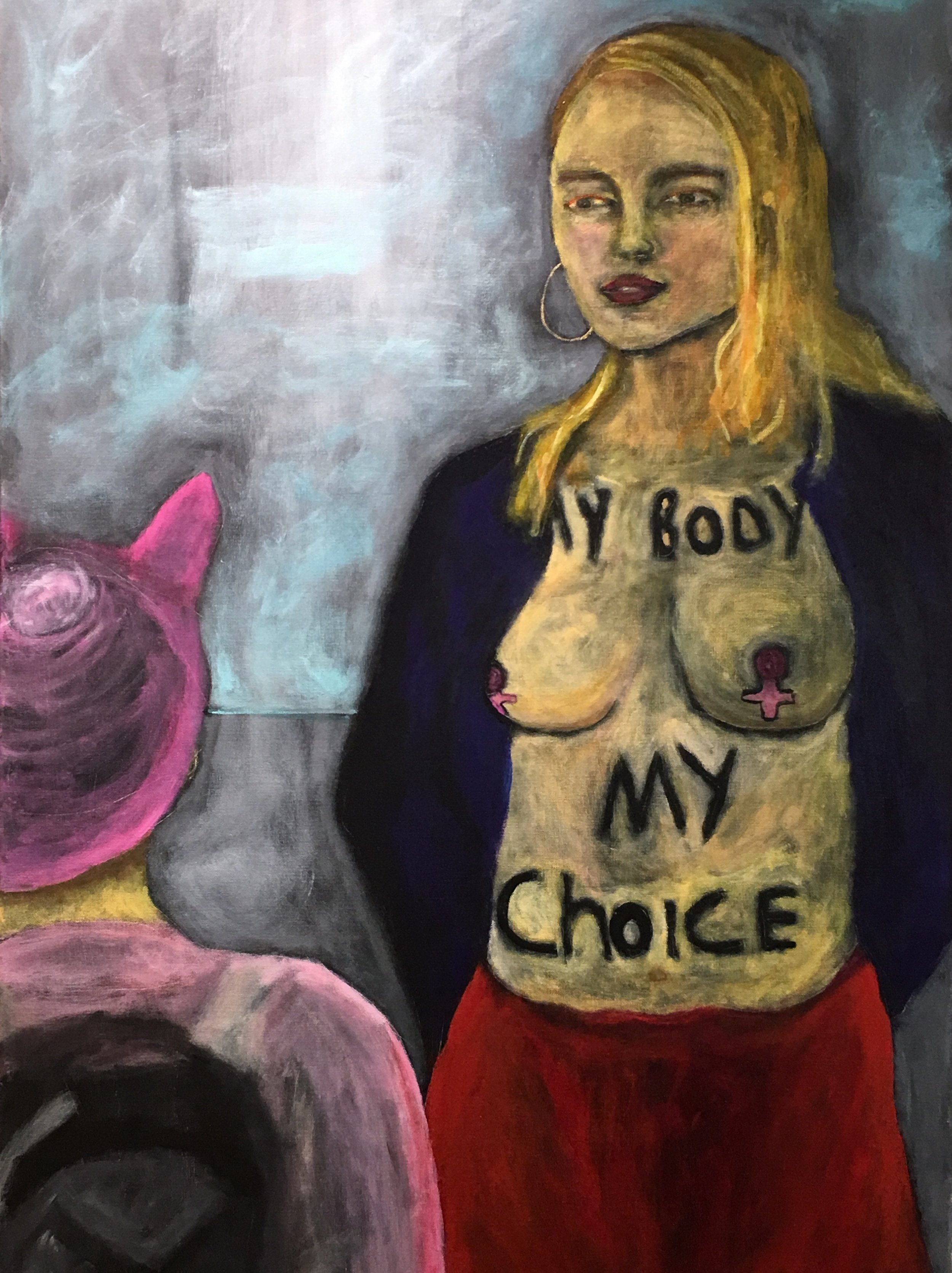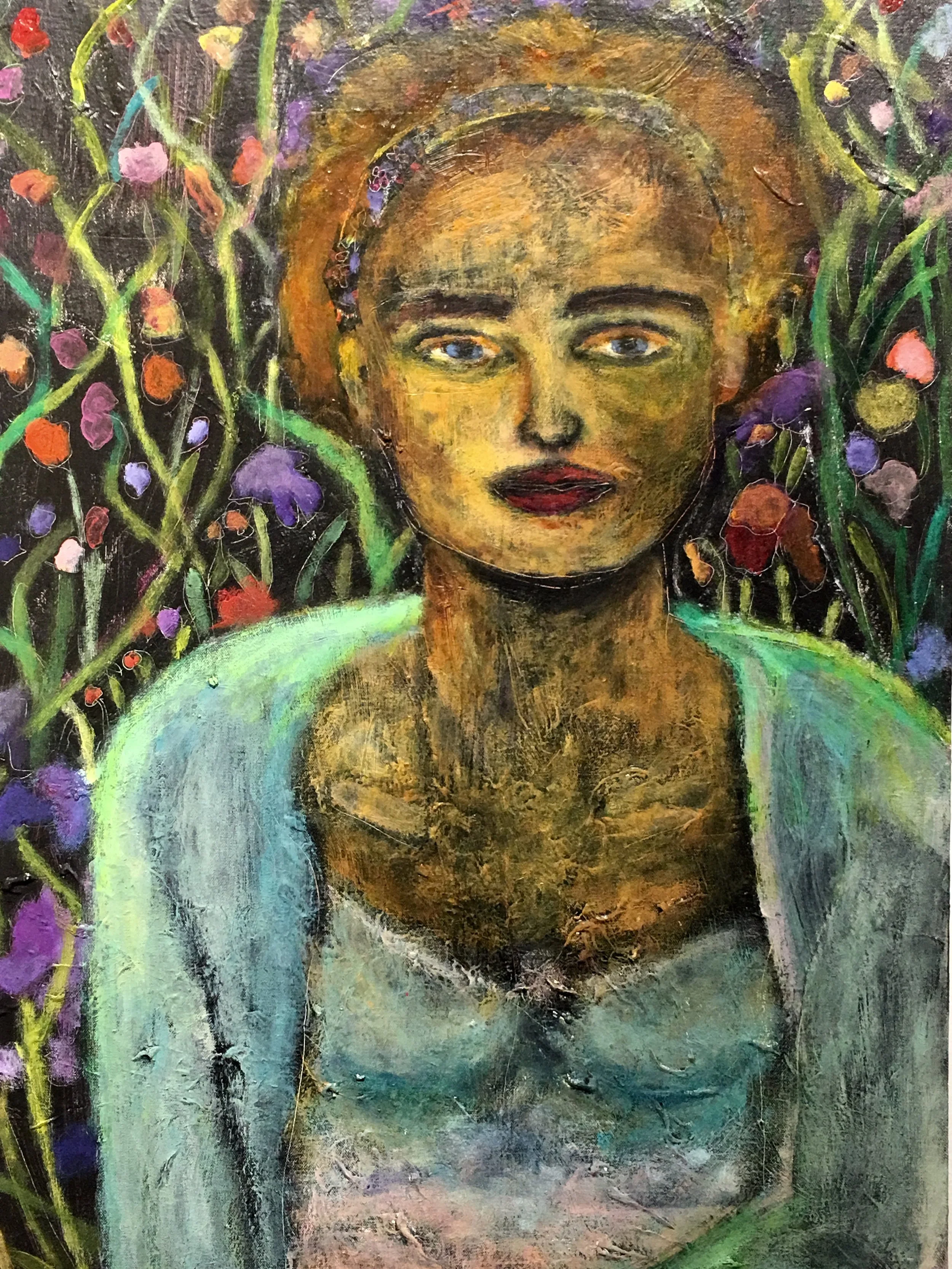
Davis Alumna, Jennifer Hirshfield, Presents Art Exhibit Inspired by Women’s Rights.
Jennifer Hirshfield explains importance of being present, painting politics.
Ally Overbay — arts@theaggie.org, The California Aggie, March 13, 2017
It’s in your newsfeed, it’s part of your dinner conversation; it’s seemingly unavoidable. Politics is everywhere — in 2017 more than ever — so when painter and Davis alumna Jennifer Hirshfield tied her smock and picked up her paintbrush, she disregarded her teachers’ warnings to keep paint and politics separate.
“We always try to stay away from politics in art — but not anymore,” Hirshfield said. “All bets are off right now. […] I couldn’t not do it. I couldn’t ignore it.”
The Santa Rosa based painter’s exhibit, Hineni… Here I Am, is her most recent body of work; it includes portraits inspired by women’s rights and the Women’s March. The exhibit is currently showing at the Walter A. Buehler Alumni Center, where it will remain until March 31.
“The actual body of work was, to a tee, influenced by politics and the Women’s March,” Hirshfield said. “I learned under the great artists of the Bay Area Figurative Movement, so right now, working with a figure, some of those figures were actually modeled from women at the march. I’m definitely influenced by what’s going on right now.”
Hirshfield describes her work as a manifestation of the philosophy of “being present.” First hearing the term through Leonard Cohen’s song and album You Want it Darker, Hirshfield’s exhibit pays tribute to the Hebrew phrase “hineni.”
JENNIFER HIRSHFIELD / COURTESY
“More specifically, it means ‘Here I am,’ and it’s interpreted as ‘Being present,’” Hirshfield said. “In this particular body of work, I felt it was more about being unapologetic about your beliefs […] Kind of of like: this is what I got; this what you get.”
Hirshfield places strong emphasis on this notion of being present. The culmination of her politically-charged art highlights the intensity of politics in everyday life.
“Even though it’s a Hebrew word, it’s the Buddhist aspect of [“hineni”] that influences me — being present,” Hirshfield said. “And that includes everything from sitting here under these blooming trees to my ocean paintings of Annadel [State Park].”
Hirshfield explained that after she was diagnosed with breast cancer, “being present” became the centerpiece of her solace. She acknowledges that it was this diagnosis that encouraged her to pursue her art more seriously.
“When I moved back [to California], I actually got breast cancer,” Hirshfield said. “At that point I said, okay, I’ve studied psychology, I’ve taught primary education […] but art was my passion — it was where I was going to go.”
Her love for art was cultivated during her studies at UC Davis. Graduating in 1987 with degrees in both art and psychology, many of Hirshfield’s art lessons were taught by internationally-recognized painters from the Bay Area Figurative Movement.
“[In Davis], the academia is mixed into the town,” Hirshfield explained. “So for instance, if you’re going to have a show, there’s all these references to the professors that you learned under. Or even having shows supported within the art department, like by Manuel Neri — the way he worked with us one-on-one, and he integrated himself into the campus. You’d be eating bagels together with your professor in the Coffee House. There was not a big boundary between being a professor and being a student. […] There was always this integration of the creative world connected with the actual people you’re working and learning under.”
After many years of painting and teaching, Hirshfield’s art comes full circle; Hineni…Here I Am, is showing on the same campus that kindled her passion in the first place. She hopes, too, that the Pence Gallery may pick up the exhibit.
“For the women’s studies majors, I think it would be great for students to come through. For anyone this interested in women’s issues, I really want to reach out and say, ‘Come see the show,’” Hirshfield said. “At the alumni center, one girl who worked there looked at the piece and said, ‘Thank you so much for doing that piece,’ and that piece reads, ‘My body, my choice.’”
The message behind Hirshfield’s exhibit is pertinent and even assertive, but its explicit imagery is simply necessary. The implications of her art are as poignant as the art itself.
“The subject matter is very forthright. There’s no kind of figuring it out; it’s convicted and moved and making a message,” Hirshfield said. “There’s one of a woman, and she has lions behind her, but a kitty cat in front — it refers to sexual assault on campuses, or anywhere for women. It’s so rampant. […] And I really felt like it’s a horrible subject, but it’s a true subject.”
But this is exactly why Hirshfield’s art is so pertinent not only in its location, but in its timing. Her paintings tell a story, from start to finish, of a bleak beginning but a powerful, female ending.
“The first image is just [a portrait of a woman] from the bust up,” Hirshfield said. “And she is looking pensive, sad — I wouldn’t even go so far as saying crushed — but it was a very demure piece. From that, going chronologically, the last piece of the show is of two women, one with her arm out, [flexing]. And they look like all power. Like nothing is going to stop them.”


